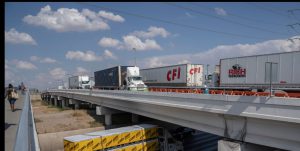Self-Driving Semi-Trucks Increase Safety, Efficiency
The future of goods transportation is being transformed by self-driving technology developed by Kodiak Robotics. Founded in 2018, the company has been working toward developing innovative solutions that help businesses transport goods more efficiently and safely.
Kodiak Robotics has developed self-driving systems for semi-trucks (Figure 1), enabling them to operate safely on highways without requiring a human driver. The company uses various technologies, including radar, LiDAR and artificial intelligence, to develop cutting-edge autonomous systems.
Kodiak is trying to spread the adoption of self-driving technology, which it believes will ultimately save lives and enhance the quality of life of truck drivers. There is an ongoing shortage of qualified truck drivers today. The average American truck driver is about 48 years old, and for long-haul truckers, the average age is even higher. Fewer people are choosing trucking as a career because of the long, fatiguing hours on the road and the pressure to deliver. Kodiak’s vision is to bring relief to drivers and redirect the industry onto a better path.The self-driving technology, known as the kodiakDriver, is designed to detect potential obstacles and respond appropriately by slowing down, changing lanes, nudging within a lane or stopping to prevent accidents.
Kodiak’s highly modular fifth-generation truck now includes even fewer required modifications and touchpoints. This enables a more cost-effective integration into trucks, which marks a significant step toward the commercial deployment of Kodiak self-driving technology.
Kodiak’s SensorPods retrofitted for fleets
The self-driving solution from Kodiak has a modular hardware system called the Kodiak SensorPod that incorporates all of the sensors required to “see” its surroundings using the truck’s conventional mirror-mount locations. The modular architecture of the pods makes it possible to install them in a matter of minutes without requiring specialists to set up the equipment and calibrate the sensor network.
According to Jamie Hoffacker, Kodiak’s vice president of hardware, the computing system, networking and power distribution have been modularized, which makes integration and servicing easier, as components can be swapped out as necessary, thus maximizing uptime. This modular approach simplifies the integration of the system into the truck, making it easier to manage when the trucks are incorporated into a customer’s fleet.
“Kodiak’s fifth-generation autonomous truck has an increased number of sensors for added redundancy,” Hoffacker said. “The sensors that were previously located in the rooftop ‘unibrow’ were relocated to the SensorPods on the easy-to-reach side-mounted mirrors, eliminating the need to access the roof for sensor maintenance. The fifth-generation truck also has more GPU processing power, central processing power, [and] system redundancy [as well as] reduced power consumption.”
Kodiak has reduced the electrical power requirements while improving the system’s processing power. The company rebuilt the high-performance computer entirely, adding a newer generation of processing chips that are more efficient and powerful than the last. Power consumption has been cut in half in a new system using power modules, limiting cooling demand and increasing efficiency.
Kodiak’s proprietary SensorPods are pre-calibrated, pre-built hardware enclosures that replace the truck’s stock side-view mirrors. Roads are designed around a human driver’s line of sight. The SensorPods, located at the same height as a driver, offer a better dual vantage point, as they provide visibility on either side of the truck as opposed to the single vantage point above the cab. In the event of sensor damage, such as a rock or other piece of debris damaging a sensor, redundant sensors are onboard.
“If one sensor is damaged or blocked by an object, the system will still have visibility from the other side,” Hoffacker said. “This ultimately maximizes road safety and improves perception.”
Furthermore, an on-the-fly replacement of a SensorPod can be performed in as little as 10 minutes. The SensorPod houses multiple sensors and can be completely removed and easily replaced while on the road by a mechanic without specialized training, maximizing the time the vehicle is utilized and, ultimately, customers’ revenue generation.

Rigorously road-tested technology ensures safety
The system’s robustness has been assessed with tests performed under various real-world and lab conditions. Key components have been designed to the ASIL-D standard, the highest automotive standard for safety and reliability. Moreover, the main connector for data and power in Kodi
ak’s SensorPods and compute system is designed for use in aviation, aerospace and military applications. The increased robustness of the hardware system is another step forward for Kodiak’s deployment readiness and unrelenting diligence to ensure safety.
Kodiak has been performing autonomous freight deliveries for IKEA in Texas since August 2022. It runs seven days a week between a Baytown distribution center and a Frisco IKEA store. Other collaborations include Pilot Company and Werner Enterprises. In March 2023, Kodiak and Forward announced they are running three weekly autonomous round-trips between Dallas and Atlanta 24 hours a day, six days a week.
Additionally, the U.S. Department of Defense (DoD) awarded Kodiak a $49.9 million, 24-month contract in December 2022 to assist with automating future U.S. Army ground vehicles intended for reconnaissance, surveillance and other high-risk tasks.
Highly reliable Vicor power modules used for ‘seeing’ sensors
The kodiakDriver solution has been implemented using power modules developed by Vicor.
“Driving down energy usage and reducing the size of Kodiak’s subsystems is essential to producing a commercial product,” Hoffacker said. “Vicor modules provide high-efficiency DC/DC conversion, enabling Kodiak to maintain a small module size and reduce cooling demands.”
Vicor power modules support the kodiakDriver’s sensors that require 12-, 24- and 48-V power supply buses. Figure 2 shows the Vicor BCM6123 (voltage bus converter), an array of PRM buck/boost regulators and VTM current multipliers. All power modules deliver reliable and highly efficient power conversion in small packages.
According to Kodiak, Vicor’s BCMs are key elements in providing isolation with a very accurate voltage ratio and high power density. Moreover, high-frequency conversion using the unique planar packaging of Vicor power modules minimizes power losses while converting many thousands of watts. This allows for smaller packing, minimal airflow/heatsink requirements and the ability to operate in higher ambient conditions.
A vast array of information across the Kodiak system is available on one CAN bus isolated from the vehicle CAN bus. The power supply, for instance, has approximately 40 individually controllable outputs. Each output has on/off control, current and voltage monitoring, control over current thresholds and status monitoring. The CAN bus improves noise immunity due to its differential inputs while allowing for many elements on the bus.
“Our system is extremely complicated, and the multi-kilowatt power conversion involves about 40 controllable outputs, all microprocessor-/CAN-controlled,” Hoffacker said. “The overall challenge was to fit the power conversion and control into one 2U rack enclosure with all interconnects, heatsinking and cooling.”
Moreover, the control circuit must work in the presence of noise generated by the power conversion. The power-dense conversion allowed the power section to be individualized in small volumes to help manage high-frequency interference. Also, the high-frequency switching made it possible to apply filtering where necessary.
Read more at-https://shorturl.at/fxGOV




Recent Comments